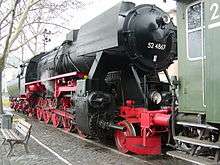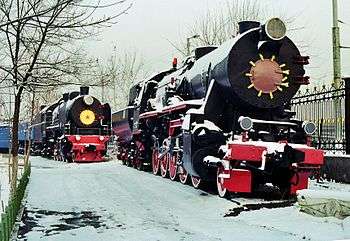DRB Class 52
| DRB Class 52 | |
|---|---|
| | |
| Number(s) | see text |
| Quantity | 7000+ |
| Manufacturer | see Text |
| Year(s) of manufacture | 1942–ca. 1950 |
| Retired | ČSD: 1976 DB: 1962 DR: 1988 ÖBB: 1976 |
| Wheel arrangement | 2-10-0 |
| Axle arrangement | 1'E h2 |
| Type | G 56.15 |
| Gauge | 1,435 mm (4 ft 8 1⁄2 in) standard gauge 1,524 mm (5 ft) Russian Railways |
| Length over buffers | 22.975 m (75 ft 4 1⁄2 in) 27.532 m (90 ft 3 7⁄8 in) (with condensing tender) |
| Overall wheelbase | 9.2 m (30 ft 2 1⁄4 in) |
| Service weight | 84.0 t (82.7 long tons; 92.6 short tons) |
| Service weight incl. tender | 102.7 t (101.1 long tons; 113.2 short tons) |
| Adhesive weight | 75.9 t (74.7 long tons; 83.7 short tons) |
| Top speed | 80 km/h (50 mph) |
| Indicated Power | 1,192 kW (1,598 hp) |
| Driving wheel diameter | 1,400 mm (55.12 in) |
| Leading wheel diameter | 850 mm (33.46 in) |
| No. of cylinders | 2 |
| Cylinder bore | 600 mm (23.62 in) |
| Piston stroke | 660 mm (25.98 in) |
| Boiler Overpressure | 16 bar (1.6 MPa; 230 psi) |
| Grate area | 3.89 m2 (41.9 sq ft) |
| Evaporative heating area | 177.83 m2 (1,914.1 sq ft) |
| Tender service weight | 18.7 t (18.4 long tons; 20.6 short tons) |
| Water capacity | 27,000 L (5,900 imp gal; 7,100 US gal) 30,000 L (6,600 imp gal; 7,900 US gal) when using an ÖBB covered tender |
| Fuel | 10.0 t (9.8 long tons; 11.0 short tons) coal |
| Train heating | Steam |
The Deutsche Reichsbahn's Class 52[note 1] was a German steam locomotive built in large numbers during the Second World War. It was the most produced type of the so-called Kriegslokomotiven or Kriegsloks (war locomotives). The Class 52 was a wartime development of the pre-war DRG Class 50, using fewer parts and less expensive materials to speed production. They were designed by Richard Wagner who was Chief Engineer of the Central Design Office at the Locomotive Standards Bureau of the DRG. About a dozen classes of locomotive were referred to as Kriegslokomotiven, however the three main classes were the Class 52, 50 and 42.
Many locomotives passed into Russian ownership after the Second World War. In the U.S.S.R. the class were designated TE (TЭ). Other operators of the type included Poland and Romania, Bulgaria, Norway and Turkey. In Yugoslavia locomotives of the type were classified JŽ 33.[1]
Overview
Over 6,700 locomotives of DRB Class 52 type were built across Europe for use on the Eastern Front during the Second World War. Thus it was one of the most numerous steam locomotives in the world. To achieve such numbers, the German locomotive manufacturers were merged into the Gemeinschaft Grossdeutscher Lokomotivhersteller (GGL), which was a subdivision of the Hauptausschuss Schienenfahrzeuge (HAS) founded in 1942. Key HAS figures were the Reichsminister for munition and armament, Albert Speer and the Reich transport minister, Julius Dorpmüller.
The GGL included the following locomotive manufacturers (including an approximate number of Class 52s produced):
- LOFAG, Vienna: 1,053 units
- Henschel, Kassel (Henschel Flugzeugwerke AG): 1,050 units (forced labor)[2]
- Schwartzkopff, Berlin: 647 units
- Krauss-Maffei, Munich: 613 units
- Borsig, Berlin; branches: Borsig-Rheinmetall AG Düsseldorf (in Siemianowice, Poland), Borsig Lokomotivwerke Hennigsdorf, Borsig Werke Breslau-Hundsfeld (now Wroclaw, Poland): 542 units (forced labor, incl. KL Auschwitz)[2]
- Schichau-Werke Elbing (now Elbląg, Poland): 505 units (forced labor, incl. KZ Stutthof,[3] and its subcamps).[4]
- Maschinenbau und Bahnbedarfs AG (MBA) formerly Orenstein & Koppel, Babelsberg: 400 units
- DWM Posen, Poznań (occupied Poland), German takeover of Polish manufacturer H. Cegielski – Poznań: 314 units (forced labor)[5]
- Oberschlesische Lokfabrik Krenau, Chrzanów (occupied Poland), German takeover of Polish manufacturer Fablok: 264 units (forced labor)[5]
- Maschinenfabrik Esslingen: 250 units
- Jung, Jungenthal, Kirchen: 231 units
- Škoda Works, Pilsen: 153 units
- Grafenstaden, Strasbourg: 139 units
Engine design
The class 52 was a simplified version of the prewar Reichsbahn class 50 locomotive (produced 1938-1942). The simplified design of the class 52 was intended to reduce the man-hours and skills needed to manufacture it and to adapt to wartime shortages of strategic materials. Additional design changes gave the locomotives and their crew better protection against the cold.[5] Between 1942 and the end of the war in May 1945 over 6,300 class 52 locomotives were built. Additional locomotives were built post-war, giving a class total of probably 6719 units, delivered by seventeen manufacturers. The Class 42 was a larger version of the Class 52, but was produced in small numbers.
In the early postwar years class 52s were used by many European countries, the largest user being the Soviet Union, which had more than 2,100 of them, designated class TE (ТЭ). Poland had more than a thousand and East Germany had about 800. The type was also widespread among other eastern European nations. Western European countries replaced them with more modern locomotives as soon as possible, with the exception of Austria where they were used until 1976. The simplicity and effectiveness, plus the large production total, meant that many eastern European countries were slow to withdraw these Kriegslokomotiven. Poland used them into the early 1990s; Turkey and Bosnia were also late users of the type.
Wagner had wanted locomotives which were long-lasting and easy to maintain, and unlike British engineers did not consider a high power-to-weight ratio a priority. The resulting Kriegslokomotive had a low axleload of 15 tons and could haul 40 percent more freight than the old Prussian locomotives they replaced. The class 52 could haul 1,200 tons at 65 kph (40 mph) without significant strain.
Countries using the engine
Following the invasion of Poland in September 1939 Nazi Germany disbanded the Polish State Railways (PKP). Polish rail officials were either executed in mass shootings or imprisoned, and some 8,000 managerial positions were staffed with German officials.[6] Former Polish companies began producing German engines BR44, BR50 and BR86 as early as 1940, some using forced labor. By 1944, the factories in Poznań and Chrzanów were producing the redesigned Kriegslok BR52 locomotives for the Eastern Front. These locomotives were made almost entirely of steel; the use of more expensive, non-ferrous metals was dropped in view of the engines' expected lifespan.[6] After the war, some 1,200 class 52s remained in reconstituted Poland. Another 200 were acquired from the Soviet Union in 1962-64. The class 52, designated Ty2, began to be phased out in the 1980s; its last regular use was in 1999.
Some 100 were built for Romanian State Railways, becoming class 150.1000 engines. Over 150 were in use by the Bulgarian State Railways as class 15. Turkish Republic Railways built 10 for forming the TCDD 56501 Class. Turkish Railways acquired 43 additional loc's at the end of the war, these had previously been on hire.
The Deutsche Reichsbahn (DR) in East Germany had 200 machines reconstructed to the new DR Class 52.80.
74 locomotives were sent to occupied Norway during World War II and were confiscated following the war. The Norwegian classification was class 63, and was nicknamed Stortysker ("big German"). One engine, restored by the Norwegian Railway Club, is preserved at the Norwegian Railway Museum in Hamar.
The ČSD Czechoslovak state railways used hundreds of 52s post-war, some left behind by the Germans after 1945, some being rebuilt by the Škoda Works in Plzeň. They bore designation class ČSD 555; several dozen were subsequently adapted, as the 555.3, to burn mazut fuel oil, a large surplus of which was generated in synthetic fuel plants in occupied Czechoslovakia from brown coal. The 555.3 differed visibly by having a lid on the smokestack to slow down cooling of the lining of the flue passage, to prevent cracking.
The Hungarian State Railways (MÁV) acquired 100 type 52s from the Soviet Union in 1963. They were designated class 520 and used into the 1980s. Others were used by Yugoslavia before that country's dissolution in the 1990s.
Gallery
Several Class 52s have been preserved in operating condition. One is at the Nene Valley Railway in Peterborough, England. Another one is in service with the Franconian Museum Railway in Bavaria, Germany.
- DB 52 4867 at the Eisenbahnmuseum Kranichstein (2005).
 DB 52 4867 of the Historische Eisenbahn Frankfurt (2004)
DB 52 4867 of the Historische Eisenbahn Frankfurt (2004) Soviet TЭ-5200 in Tashkent, Uzbekistan (2003).
Soviet TЭ-5200 in Tashkent, Uzbekistan (2003). Austrian (ÖBB) 52 6084 (1971).
Austrian (ÖBB) 52 6084 (1971). Austrian (ÖBB) 52 class rebuilt with tender cab, Giesl ejector, Graz (1971).
Austrian (ÖBB) 52 class rebuilt with tender cab, Giesl ejector, Graz (1971)..jpg) Soviet ТЭ-6769 (ex-Class 52) preserved at St. Petersburg (2007).
Soviet ТЭ-6769 (ex-Class 52) preserved at St. Petersburg (2007). 52 class as running after the War on PKP as class Ty2 (August 1976).
52 class as running after the War on PKP as class Ty2 (August 1976). Reconstructed DR 52 8177-9 in Dresden (2003).
Reconstructed DR 52 8177-9 in Dresden (2003).- Reconstructed DR 52 8109-2 in Weimar (2003).
- The most up to date class 52, 52 8055 completely rebuilt, Hauenstein.
In media and popular culture
The Kriegslokomotiven are featured in the third sequel of the successful computer game series Railroad Tycoon under the name "Kriegslok 2-10-0". A DRB 52 Kriegslokomotive was also used in the official music video for Extreme's "Stop the World" in model railway form. An actual Kriegslokomotive was also used for the video. An inconsistency can be seen where the model DRB 52 used for the opening (and briefly near the end) has boiler fins, while the real DRB 52 that is shown afterwards does not.
Notes
- ↑ Wartime locomotives classes are prefixed DRB (Deutsche Reichsbahn) to distinguish them from those introduced by the DRG (prefixed DRG), which became defunct in 1937, and those introduced later by the East German Deutsche Reichsbahn (prefixed DR).
See also
- The Museum of the Moscow Railway, at Paveletsky Rail Terminal, Moscow
- Rizhsky Rail Terminal, Moscow, Home of the Moscow Railway Museum
- Varshavsky Rail Terminal, St.Petersburg, Home of the Central Museum of Railway Transport, Russian Federation
- History of rail transport in Russia
References
- ↑ "Serija JŽ 33 (Kriegslokomotive DRB 52)", www.stacion.hr (in Croatian)
- 1 2 Eliah Meyer (July 1949). "List of german firms that used prisoners from concentration camps for slave labor". Catalogue of Camps and Prisons in Germany and the German-Occupied Territories. The International Tracing Service, ITS. Retrieved 11 August 2014.
- ↑ Geoffrey P. Megargee, USHMM (2009). The United States Holocaust Memorial Museum encyclopedia of camps and ghettos, 1933-1945. Indiana University Press. ISBN 0253354293. Retrieved 11 August 2014.
- ↑ J. Więsyk (2015). "Gdańsk-Kokoszki - KL Stutthof Sub Camp". Virtual Shtetl. POLIN Museum of the History of Polish Jews. Retrieved 10 March 2015.
- 1 2 3 Michał Kubara; Beata Mamcarczyk; Marcin Paździora; Sandra Schab (2012). "Sosnowiec". Katalog Zabytków Techniki Przemysłowej Zagłębia Dąbrowskiego (PDF file, direct download 9.97 MB). Zagłębiowska Oficyna Wydawnicza Publishing. pp. 84–85. ISBN 978-83-928381-1-1. Retrieved 9 February 2014.
- 1 2 Jerzy Wasilewski (2014). "25 września. Wcielenie kolei polskich na Śląsku, w Wielkopolsce i na Pomorzu do niemieckich kolei państwowych Deutsche Reichsbahn (Takeover of Polish Railways in Silesia, Greater Poland and Pomerania)". Polskie Koleje Państwowe PKP. Archived from the original on 8 February 2014. Retrieved 8 February 2014 – via Archive.is.
- Peter Slaughter; Alexander Vassiliev; Roland Beier (1996). The German Class 52 Kriegslok (in English and German). Frank Stenvalls Förlag. ISBN 91-7266-140-2.
External links
| Wikimedia Commons has media related to DRB Class 52. |